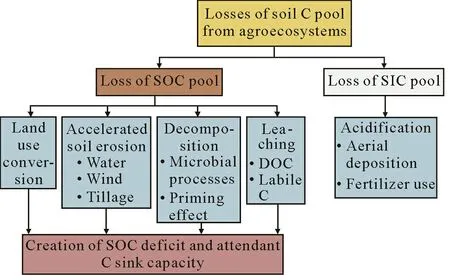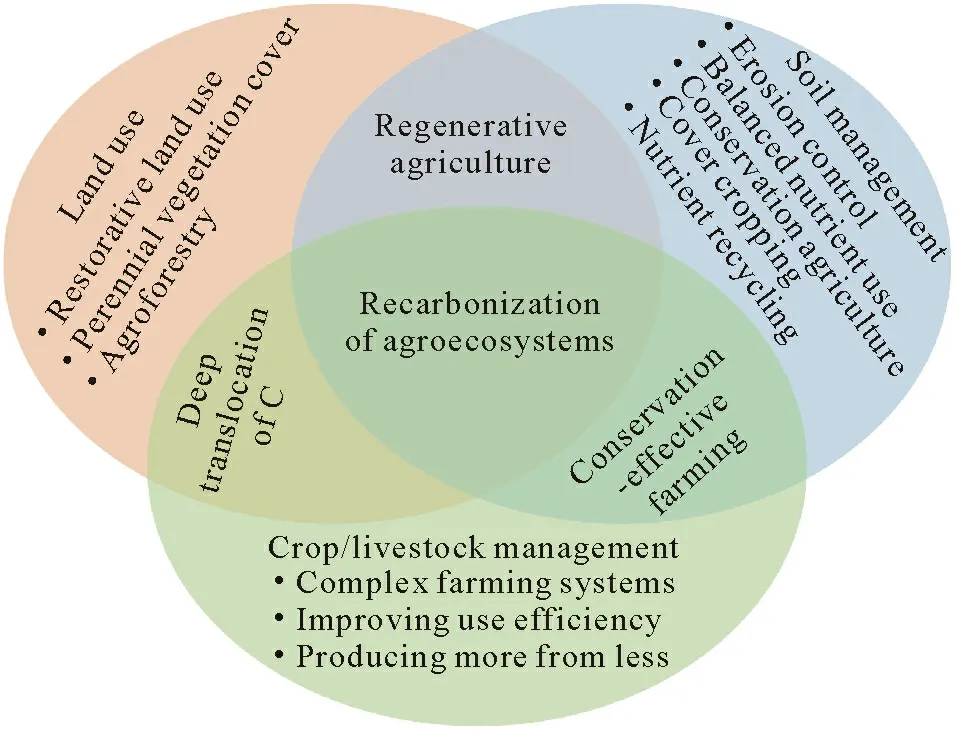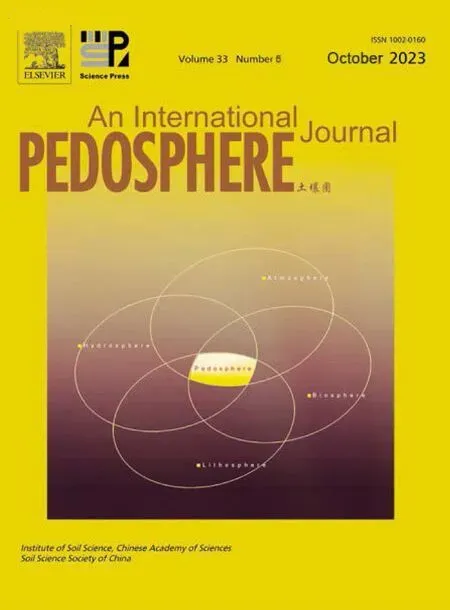Carbon farming by recarbonization of agroecosystems
Carbon(C)farming refers to deliberate adoption of restorative land use and site-specific best management practices which create a positive soil/ecosystem C budget and lead to sequestration of atmospheric carbon dioxide(CO2)in soil and biomass such that increase in soil/terrestrial C stock can generate another income stream for land managers.Land-based C sequestration can be in biomass(above-and belowground)and increase in soil C pool.The latter comprises of soil inorganic C(SIC)and soil organic C(SOC)pools.Sequestration of C as SIC pool is through formation of secondary carbonates and leaching of bicarbonates with irrigation water.Sequestration as SOC pool occurs through biogeochemical transformation of biomass C(roots and shoots)into labile C,particulate organic C,and microbial biomass C fractions which upon reactions with clay colloids form organo-mineral complexes and get protected within stable microaggregates.The passive fraction has a long mean residence time and thus is the target of a C farming initiative.Some examples of practices which are adopted for C farming include conservation agriculture with residue mulching and cover cropping,agroforestry,complex farming systems based on integration of crops with trees and livestock,systems involving integrated nutrient and pest management,those based on precision agriculture and sub-drip fertigation,and growing special crops with favorable root system and biomass production.Temporal changes in soil C pool must be measured to 1-m depth along with those in bulk density for different layers.The overall objective of C farming is to grow C in land-based sinks and use it as a commodity to generate income while making agriculture a solution to climate change and restoring the environment.
Agriculture is a process of harvesting carbon(C)compounds photosynthesized by plants through cultivation of site-specific crops and raising of livestock.Indeed,C-based compounds are contained in food products of all crops,livestock,and forestry systems grown/raised on diverse soils.The C stock is the largest in soil(2 500 Pg to 1-m depth)(Batjes,1996)among the terrestrial C stocks,being only 620 Pg in vegetation(Lal,2004)and 880 Pg in the atmosphere(Lal,2018).The natural process of coupled cycling of C(with those of H2O,N,P,and S)supports all life on Earth(Waniet al.,2023)through provisioning and strengthening of critical ecosystem services essential to human wellbeing and nature conservancy.Decoupling of these cycles,by anthropogenic activities,leads to disservices such as accelerated surface runoffand soil erosion(Lal,2003)and human malnutrition aggravated by soil degradation(Lal,2009).Depletion of soil organic C(SOC)stock to below the critical range(1.5%—2%by weight in the root zone)is the primary driver of soil degradation and decrease in capacity of the soil to generate ecosystem services such as sequestration of atmospheric carbon dioxide(CO2)in land-based sinks,renewability and quality of water,strengthening activity and species diversity in soil,etc.As much as one-third of Earth’s land area and especially agricultural soils,including those managed by resource-poor and small landholder farmers(estimated to be about 500 million globally),are strongly depleted of their SOC content in the root zone because of land misuse and soil mismanagement over a long period of time.Over and above the adverse effects on negative nutrient balance,SOC depletion is also caused by vulnerability of soil to accelerated erosion by water and wind,salinization,compaction and crusting,and other soil degeneration processes(Fig.1).A report of FAO and ITPS(2015)indicates that decline of soil health is a serious global issue that needs to be urgently addressed.Degraded soils,severely depleted of their SOC stocks and nutrient reserves and prone to elemental imbalance along with acidification and alkalinization aggravated by poor structural stability,are of poor quality/health and need to be restored.In general,C farming refers to sequestering and storing C and/or reducing greenhouse gas emissions at farm level (McDonaldet al.,2021).In this article,however,C farming refers to a management system for recarbonization of soils of agroecosystems while creating another income stream for farmers and mitigating anthropogenic climate change.

Fig.1 Soil degradation processes which lead to depletion of soil organic C(SOC)pool.
Magnitude of C depletion in agroecosystems.Agricultural lands have been a major source of CO2as well as other greenhouse gases including methane(CH4)and nitrous oxide(N2O)since the dawn of settled agriculture.A range of mechanisms of loss of SOC pool from agroecosystems and that of SIC through acidification are outlined in Fig.2.The global rate of annual SOC loss is estimated at 21.80±0.91 g C m-2year-1(Abdallaet al.,2020).The loss of SOC pool is aggravated by conversion of natural to agroecosystems because of deforestation,biomass burning,and relatively lower input of litter or other plant residues.Acceleration of soil erosion,on sloping land by surface runoffand on flat land by aeolian processes under plowed soil conditions,is the cause of a preferential removal of SOC because of its low density and the fact that it is concentrated in close proximity to the surface layer(Lal,2003,2004).Changes in soil temperature and moisture regimes on cultivated lands can also accelerate decomposition of the labile C fractions.The rate of decomposition increases with increase in temperature.Decomposition-based gaseous emissions include those of CH4and N2O under anerobic conditions when air porosity is<0.1.To a lesser extent,SOC loss can also occur due to leaching of dissolved organic C (DOC) and other labile C fractions(simple polysaccharides).Reaction of calciferous material with chemical fertilizers and other acidification-causing inputs can cause loss of SIC pool with attendant emission of CO2(Fig.2).Over and above the loss of SOC pool and the attendant decline in soil quality/health,decline in soil structure and porosity leads to prevalence of methanogenesis with emission of CH4and that of nitrification/denitrification with emission of nitrogen oxides(NOx,especially N2O).The magnitude of SOC loss may range from 50%to 75%in strongly and severely degraded soils and 25% to 50% in slightly and moderately eroded soils.Agricultural soils globally may have lost as much as 135 Pg SOC pool(Lal,2018).

Fig.2 Mechanisms of soil organic C(SOC)pool loss from agroecosystems and soil inorganic C(SIC)pool loss through acidification by aerial deposition and use of nitrogenous fertilizers.DOC=dissolved organic C.
Components of soil C pool.Total soil C pool comprises of numerous pools(Fig.3)which are broadly classified into inorganic and organic components.To 1-m depth,global SOC stock is estimated at 1 550 Pg and SIC stock at 950 Pg(Batjes,1996).The SIC pool comprises of primary or lithogenic carbonates derived from weathering of parent material and secondary carbonates or pedogenic C derived from soil processes.Formation of secondary carbonates and leaching of bicarbonates with irrigation water also involves sequestration of atmospheric CO2(Mongeret al.,2015).The SOC pool comprises of labile or active C pool that includes DOC and microbial biomass C (MBC).The intermediate SOC pool includes particulate organic C(POC).The labile and intermediate pools are also called extractable organic C(EOC).Passive C pool,which is protected against microbial processes by several mechanisms(e.g.,physical,chemical,biological,and ecological),has the longest mean residence time (MRT).It is the lack of access of SOC to microbial processes that enhances its MRT by protection through several mechanisms(Dungaitet al.,2012).Pertinent among these protective mechanisms is the encapsulation of SOC within stable microaggregates.Therefore,objective of soil C sequestration is to promote adoption of land use and soil/crop/livestock management practices which enhance the passive fractions and those which have a long MRT.Yet,passive fractions with long MRT must pass through the active/labile and EOC fractions(Fig.3),which is the eye of a needle through which all fractions must pass to become a stable/protected SOC pool.

Fig.3 Components of soil C pool and the relation between soil organic C(SOC)and formation of secondary carbonates.Secondary carbonates are formed through dissolution of CO2 evolved from decomposition of labile C pool to form weak carbonic acid and reaction with cations transported from outside the system.SIC=soil inorganic C;DOC=dissolved organic C;POC=particulate organic C;MBC=microbial biomass C;EOC=extractable organic C.
Landuse andmanagement systems for recarbonization of terrestrial biosphere.There are a range of site-specific land use and management practices which lead to soil C sequestration and enhance MRT(Lal,2008).Soil is like a bank account.For the C budget to increase,the input of C into soil must be more than the loss of C.Furthermore,soil C must be treated as a commodity (such as wheat,corn,milk,and meat)from which farmers can get income.There is no one-size-fits-all or a universally applicable practice which can increase the soil C pool.Some examples of these practices include conservation agriculture(CA)used in conjunction with retention of crop residues as mulch,cover cropping,and complex systems based on integration of crops with trees and livestock (Fig.4).Other practices include agroforestry,integrated nutrient and pest management,water harvesting and recycling,sub-drip fertigation,precision farming or digital agriculture,use of artificial intelligence,drones,remote sensing,etc.Padarianet al.(2022)estimated storage potential of global croplands at 29—65 Pg C through adoption of best management practices.The overall objective is to“produce more from less”and save land and water for nature.Janssonet al.(2021)outlined the need for breeding crops specifically for C farming.Carbon storage by these crops can be increased through:1)increased root strength for allocation of C belowground,2)enhanced photosynthesis and biomass production,and 3)increased rhizosphere sink strength and plant growth properties by designing soil microbial consortia(Janssonet al.,2021).The rate of SOC sequestration is more under cool and humid climate(500—1 500 kg C ha-1year-1)than under warm and dry climate(50—500 kg C ha-1year-1).In general,the rate of SIC sequestration is lower,albeit with a higher MRT,than that of SOC(Lalet al.,2004;Mongeret al.,2015;Schlesinger and Bernhardt,2020).Furthermore,increase in SOC has more beneficial/ameliorative effect on soil health,use efficiency of inputs,and agronomic productivity(Lal,2004)than that in SIC as secondary carbonates.Therefore,there is a need of policy which motivates farmers to grow C in soil,recarbonize the agroecosystems,and make agriculture a solution to environmental issues such as adaptation and mitigation of climate change.Carbon farming will also improve farm income and make it a commodity.

Fig.4 Land use and agricultural management systems which lead to a positive soil/ecosystem C budget and the attendant recarbonization of agroecosystems which makes agriculture a part of the solution.
Needfor using modern farming innovations andpolicy interventions.There is a strong progress in innovative advanced technologies and methods of C farming along with how to detect and measure changes in soil C stock using infrared spectroscopy and hand-held devices for in-field assessment of soil C and other indicators of soil health.Science must be translated into action by upscaling through cooperation between academicians on one side and private sector and policy makers on the other side.Similarly to modern innovations,there is also a strong need to adopt policies which are pro-nature,pro-agriculture,and profarmers.Rather than subsidies,farmers should be rewarded financially through payments for ecosystem services.It is hoped and timely that the forthcoming U.S.Farm Bill of 2024 should contain provisions for implementation of the so-called“Soil Health Act”to compliment the Clean Air Act(1992)and the Clean Water Act(1972)of the U.S.Environmental Protection Agency (US EPA).While there is always an ongoing need for additional research on identification of land use and management practices which restore soil health and increase sequestration of SOC and SIC in a range of agroecosystems in diverse global ecoregions,the time is right for implementation of what is already known and has been proven under laboratory,greenhouse,plot scale,and long-term field experiments.There are still seven years left in accomplishment of the Sustainable Development Goals(SDGs)of the Agenda 2030 of the United Nations.Recarbonization of soils of agroecosystems can advance SDGs and keep on the track for accomplishments.Despite some challenges which need to be addressed (Thompsonet al.,2021),soil C sequestration through recarbonization of agroecosystems is a win-win-win option.It adapts to and mitigates climate change,eliminates hunger and malnutrition,and ends poverty by creating an income stream for farmers.Carbon farming is a bridge to the future until no-C renewable energy sources take effect.
Conclusions.Carbon farming creates opportunity for farmers to restore soil health,adapt to climate change,and provide another income stream.It also makes agriculture a part of the solution to addressing environmental issues.There are several practices(e.g.,conservation agriculture,specially designed crops,and complex farming systems)which lead to C sequestration in soil and vegetation.There are also several challenges which need to be addressed.Development of a protocol for payments to farmers and establishment of mechanisms for determination of fair price based on societal value of C are among priority issues.Payments should be made for land use and soil management practices which can be identified by remote sensing.There is no need for any other testing or modeling.The U.S.Farm Bill of 2024 should have provisions for payments to farmersviaSoil Health Act.These payments will make agriculture a part of the solution to addressing climate change and advancing food security and achieving other SDGs.Payments for C farming will also promote widespread adoption of best soil management practices such as system-based conservation agriculture.
- Pedosphere的其它文章
- Root exclusion methods for partitioning of soil respiration:Review and methodological considerations
- Utilization of lignocellulosic plant residues for compost formation and its role in improving soil fertility
- A critical review of microbially induced carbonate precipitation for soil stabilization:The global experiences and future prospective
- Hand-feel soil texture observations to evaluate the accuracy of digital soil maps for local prediction of soil particle size distribution:A casestudy in Central France
- Influence of soil physicochemical properties,particle size fractions and mineralogy on the leaching potentials of arsenic and antimony in abandoned mine soils
- Viscoelasticity and shear resistance at the aggregate scale of structured and organic carbon-free Chernozems

